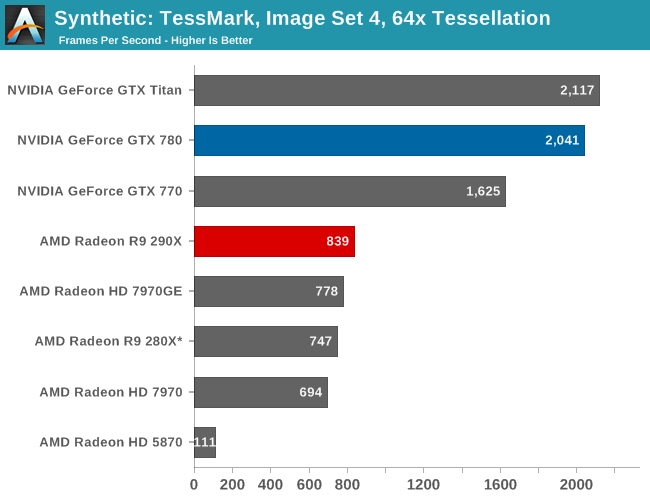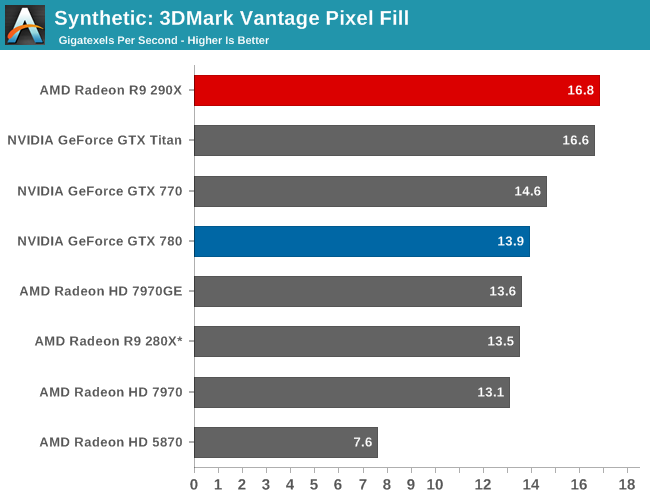The AMD Radeon R9 290X Review
by Ryan Smith on October 24, 2013 12:01 AM EST- Posted in
- GPUs
- AMD
- Radeon
- Hawaii
- Radeon 200
Synthetics
As always we’ll also take a quick look at synthetic performance. The 290X shouldn’t pack any great surprises here since it’s still GCN, and as such bound to the same general rules for efficiency, but we do have the additional geometry processors and additional ROPs to occupy our attention.

Right off the bat then, the TessMark results are something of a head scratcher. Whereas NVIDIA’s performance here has consistently scaled well with the number of SMXes, AMD’s seeing minimal scaling from those additional geometry processors on Hawaii/290X. Clearly Tessmark is striking another bottleneck on 290X beyond simple geometry throughput, though it’s not absolutely clear what that bottleneck is.
This is a tessellation-heavy benchmark as opposed to a simple massive geometry bencehmark, so we may be seeing a tessellation bottleneck rather than a geometry bottleneck, as tessellation requires its own set of heavy lifting to generate the necessary control points. The 12% performance gain is much closer to the 11% memory bandwidth gain than anything else, so it may be that the 280X and 290X are having to go off-chip to store tessellation data (we are after all using a rather extreme factor), in which case it’s a memory bandwidth bottleneck. Real world geometry performance will undoubtedly be better than this – thankfully for AMD this is the pathological tessellation case – but it does serve of a reminder of how much more tessellation performance NVIDIA is able to wring out of Kepler. Though the nearly 8x increase in tessellation performance since 5870 shows that AMD has at least gone a long way in 4 years, and considering the performance in our tessellation enabled games AMD doesn’t seem to be hurting for tessellation performance in the real world right now.
Moving on, we have our 3DMark Vantage texture and pixel fillrate tests, which present our cards with massive amounts of texturing and color blending work. These aren’t results we suggest comparing across different vendors, but they’re good for tracking improvements and changes within a single product family.

Looking first at texturing performance, we can see that texturing performance is essentially scaling 1:1 with what the theoretical numbers say it should. 36% better texturing performance over 280X is exactly in line with the increased number of texture units versus 280X, at the very least proving that 290X isn’t having any trouble feeding the increased number of texture units in this scenario.

Meanwhile for our pixel fill rates the results are a bit more in the middle, reflecting the fact that this test is a mix of ROP bottlenecking and memory bandwidth bottlenecking. Remember, AMD doubled the ROPs versus 280X, but only gave it 11% more memory bandwidth. As a result the ROPs’ ability to perform is going to depend in part on how well color compression works and what can be recycled in the L2 cache, as anything else means a trip to the VRAM and running into those lesser memory bandwidth gains. Though the 290X does get something of a secondary benefit here, which is that unlike the 280X it doesn’t have to go through a memory crossbar and any inefficiencies/overhead it may add, since the number of ROPs and memory controllers is perfectly aligned on Hawaii.










396 Comments
View All Comments
jljaynes - Friday, October 25, 2013 - link
to be fair, he says it's expected to be - he doesn't call out price explicitly.and i am not making this up - i skipped ahead in the video because he was annoying me - and he was still talking about the looks of the card. to me the reviews seem more like an nvidia commercial. i clicked around the entire video - he spends the entire tests talking about specs and thermals.
looncraz - Friday, October 25, 2013 - link
I've read a few reviews and noticed a trend you can verify:While gaming, the 290x only draws about the same amount as the 780, while putting out 10% or better average performance. It is only when you REALLY push the 290x that it draws its highest power - and to do that requires special tweaks from the reviewers, negating reality.
The noise is a problem, the heat is a problem, the performance and power draw really are not. An overclocking a video card is about the dumbest thing ever... yeah, let's risk damaging a $500+ part for an extra 5% higher frame rate... It isn't like a $200 CPU where you go from 3.2GHz to 5GHz...
No, we're talking about going from 1GHz to 1.1GHz.... and spending a premium for better cooling on top of it all...
siliconwizard - Thursday, October 24, 2013 - link
Sure does and an amazing price that is. RIP Titanchizow - Thursday, October 24, 2013 - link
Article chart says $550, Newegg has them in stock now for $580 which may just be BF4 bundle premium: http://www.newegg.com/Product/Product.aspx?Item=N8...Noble07 - Thursday, October 24, 2013 - link
Yup. The bundled version will cost $580. If you look at the newegg page, you'll see is manufacturer has two products up, one with bf4 and one without.patrioteagle07 - Thursday, October 24, 2013 - link
Newegg normally charges $20+ over msrp launch week... MSRP is $549 ...PCboy - Thursday, October 24, 2013 - link
And the Titan is $1000. Just face the facts, Nvidia got rolled.dragonsqrrl - Thursday, October 24, 2013 - link
Rolled? Price drops sir. 8 months on, price drops.tuklap - Thursday, October 24, 2013 - link
but will they drop to the same level as r9 290x? seems to me that 290x is a great buy. take note. that is just the reference performer. What more for the AIB partners ^_^ PRICE DROPS PLEASE!!Shark321 - Thursday, October 24, 2013 - link
Titan is a compute card. In 3 weeks there will be 780Ti for $599, about 5-10% faster than 290X.